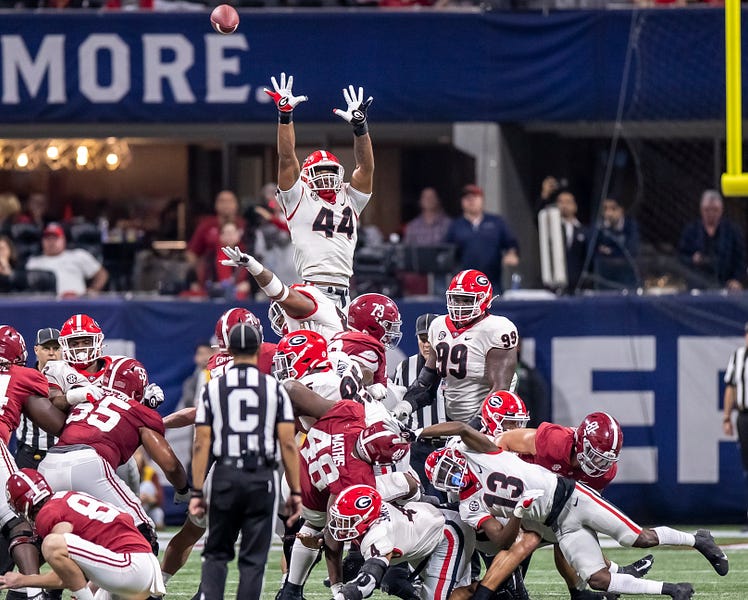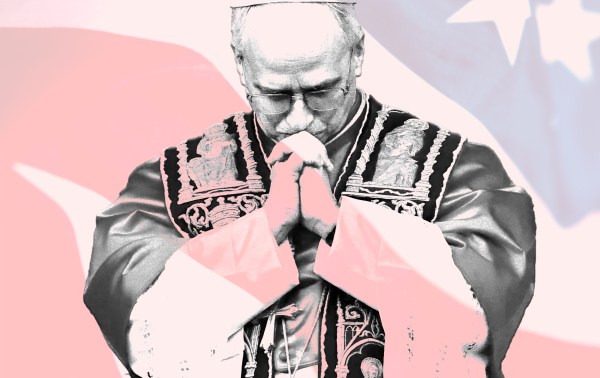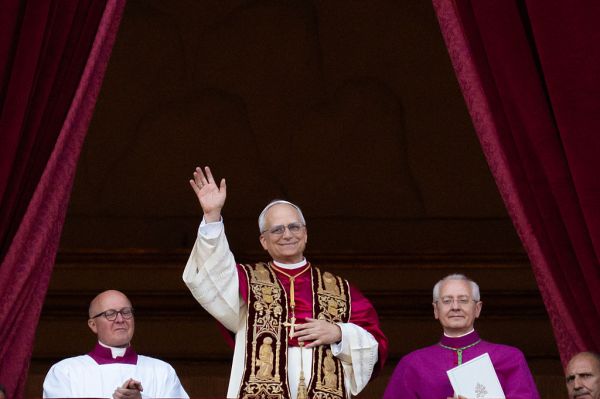In two weeks, millions of fans across the country will file into stadium seats or flop down in front of their flatscreens for the start of the college football season. What they see will feel familiar—but it won’t be business as usual. In fact, the business of college sports has almost never been this unusual.
Last year, Texas and Oklahoma announced they were abandoning the Big 12 for the Southeastern Conference in 2025. In June, USC and UCLA—two Los Angeles schools that have each been in the Pac-12 for about a century—announced they will be jumping ship and joining the Big Ten in 2024.
These two moves have the SEC and the Big Ten poised to become 16-team megaconferences with previously unheard-of television and media revenue distributed among member schools—in the case of the Big Ten, “at least $80 million per year” per school, according to The Athletic. The rest of the “Power 5” conferences—the Big 12, the Atlantic Coast Conference, and especially the Pac-12, which will have only 10 members once USC and UCLA depart—are scrambling to catch up, and no one’s certain of what comes next.
“Realignment, as the college sports industry refers to conference-membership changes, has offered episodic doses of athletic and administrative chaos for generations,” the New York Times reported last month. “What has made this stretch particularly remarkable is the eagerness of marquee brands to flee leagues in which they wielded extraordinary prestige and leverage.”
Both the conferences and the universities involved seem to be acting out of rational self-interest—the schools that are switching conferences have calculated that there is more prestige and leverage (and money) to be had elsewhere, and the conferences that are growing are tapping into the prestige and leverage of the members they’re recruiting.
Some schools are motivated by debt and others by greed, but all are feeling immense financial pressure. The members of the ACC are stuck with a comparatively paltry media payout—with exorbitant penalties for those who might want to leave before 2036.
The conference perspective is a little different. “The last round of realignment [in 2013-2014] was really about getting into major media markets to get the best TV deal possible,” Chris Marsicano, a professor at Davidson College who studies institutions of higher education, told me. Today, as cable has given way to streaming, the geographical constraints of TV media markets have become less important.
“This round seems to be about legacy brands,” Marsicano said. “For instance, the SEC does not need to add Texas or Oklahoma to get into those media markets, because it already has Texas A&M—it already has a presence in the region. This is about getting those legacy college football brands all in the same conferences.”
But what is perhaps most striking about this round of realignment is how much college football fans and commentators don’t like it.
“College Football Can’t Be Killed. But It Can Be Changed for the Worse,” a recent Ringer headline proclaimed.
The Big Ten used to be a Midwestern conference. It added Maryland and Rutgers in 2014, and the addition of UCLA and USC means the conference now spans the entire country. The states of Texas and Oklahoma make up a big chunk of Big 12 country, but now their flagship programs are signing on with a conference that formerly epitomized the Deep South.
“The established identities of the Big Ten and other conferences — once organic groupings based on geography — are disappearing like regional accents, and well-meaning but ultimately misguided rule changes are turning college football into a de facto minor league for the National Football League,” Matthew Walther complained in the New York Times, alluding to new transfer portal rules which uncannily resemble “free agency” in the NFL.
“This ‘new landscape’ of college football is not new at all but rather the black decay of a half-century of totally unrestrained commercialization by the administrators,” Sally Jenkins lamented in the Washington Post. Last year’s brouhaha over name, image, and likeness (NIL) deals for athletes was just a sideshow—“the real people leeching [the sport] of originality and distinctiveness were the ones sitting in the corner offices.”
Are these complaints fueled by anything more than just cranky nostalgia? After all, the quality of play should be better than ever, and TV deals can be lucrative only if people are expected to watch.
To better understand this phenomenon, it’s worth returning to a foundational parable of modern economics and environmental science: the tragedy of the commons.
First introduced by William Forster Lloyd in the 19th century, the tragedy of the commons was popularized by Garrett Hardin in a 1968 article in the journal Science. It concerns a public good—an unregulated piece of “common” land—that becomes overused and thus loses its value. (Unfortunately, although Hardin was a notorious eugenicist and racist obsessed with the idea of human overpopulation, his telling of the story remains the most cited.)
“Picture a pasture open to all,” Hardin wrote. While each rational, self-interested individual herdsman will benefit by keeping as many of his cattle on the pasture as possible—increasing the size of his overall herd while reducing the cost of feeding them—all herdsmen suffer when overgrazing decreases the land’s utility.
“Therein is the tragedy,” he wrote. “Each man is locked into a system that compels him to increase his herd without limit—in a world that is limited.”
When it comes to human populations, Hardin was proven wrong, like Thomas Malthus before him, because he grossly overestimated the world’s limits and underestimated humanity’s capacity to adapt to new conditions. But the tragedy of the commons remains one canonical example of what economists call a public goods problem. And sports are full of public goods problems.
By pursuing TV money and abstract “prestige” without regard to historical rivalries and regional cultures, the conferences and the schools they represent are behaving in a rational, self-interested manner that makes sense for each entity individually while “overgrazing” and cheapening the overall product that is college football.
“The NCAA probably doesn’t want to compete solely on the dimension of sports quality,” Michael Makowsky, an economist at Clemson University, told me. “I’m not an expert in forecasting where sports is going, but I do know that changing the nature of your product, changing the nature of the community that enjoys your product … that’s a risk. They’re messing with the market. Be careful what you ask for, you might get it.”
In addition to this tragedy of the commons, there are other public goods problems that could beleaguer college sports in the years to come.
Student athletes now have the ability to profit from NIL deals—but by and large, they remain “grotesquely underpaid relative to their marginal product,” Makowsky said. Realignment could likely make that under-compensation even more extreme. Even in the big-dollar sports of football and basketball, the vast majority of student-athletes don’t go on to play their sport professionally. And with megaconferences now spanning the continent, the demands on those students’ labor in terms of travel and logistics is only going to increase.
In that context, “money stands to democratize college sports, college football specifically,” Makowsky said. “Shifting to good old fashioned monetary compensation [would probably] lower the barrier to entry to putting together a pretty decent team.”
For now, however, the institutions that “contribute the most of the pie are trying to keep more of the pie for themselves. … The NCAA is eating itself a little bit.” As the best teams in the two megaconferences increasingly become the center of the already unequal college football universe, the schools and fan bases on the periphery could end up feeling less connected and invested. And that dynamic in turn could have downstream effects.
The amount of TV revenue flowing to even the worst-performing schools in the Big Ten and SEC create incentives to freeride—a “U-shaped relationship between outcomes and investment,” Makowsky said. And that fundamental incentive structure will persist no matter how prestigious and winning a conference is.
The intense focus on football in the realignment negotiations has also sown confusion among fans of non-football sports. Basketball, for example, is hardly being considered in these realignment conversations—which, for fans of historically winning programs like Duke (ACC), North Carolina (ACC), or Kansas (Big 12), feels strange. At the same time, the annual potential financial windfall presented by the March Madness college basketball tournament might be the only thing keeping the new Big Ten and SEC from separating from the NCAA altogether.
“In normally such a slow moving world, things are moving pretty quickly,” Marsicano noted. Fans will keep filling the seats; players will keep throwing, kicking, and blocking; Nick Saban will keep his same annoyed facial expression. But as everyone gears up for the 2022 season, the institutional apparatus that surrounds the sport has almost never been so tenuous. Fans should enjoy it while it lasts.






Please note that we at The Dispatch hold ourselves, our work, and our commenters to a higher standard than other places on the internet. We welcome comments that foster genuine debate or discussion—including comments critical of us or our work—but responses that include ad hominem attacks on fellow Dispatch members or are intended to stoke fear and anger may be moderated.
With your membership, you only have the ability to comment on The Morning Dispatch articles. Consider upgrading to join the conversation everywhere.